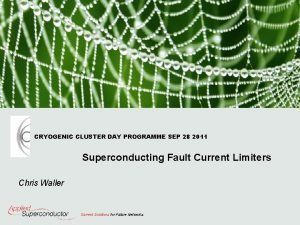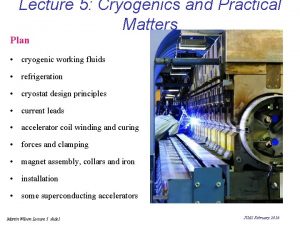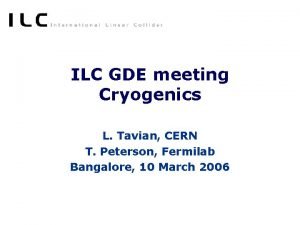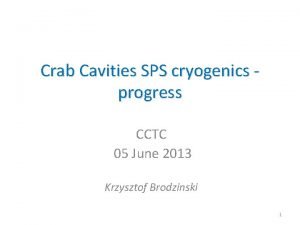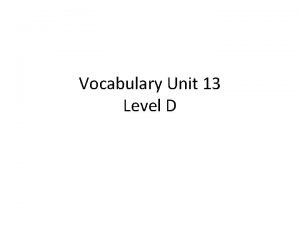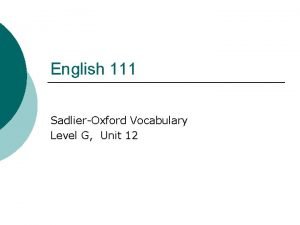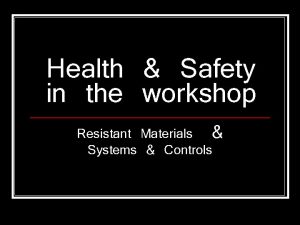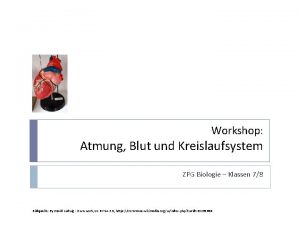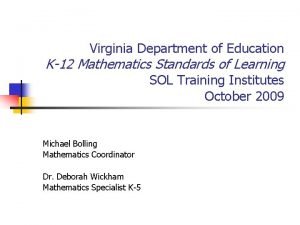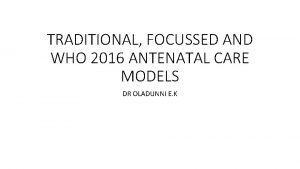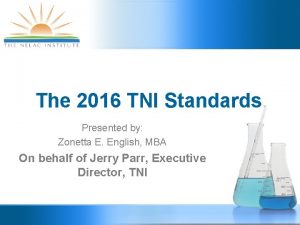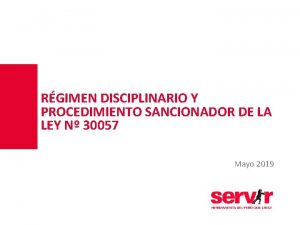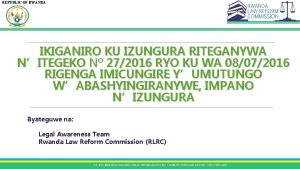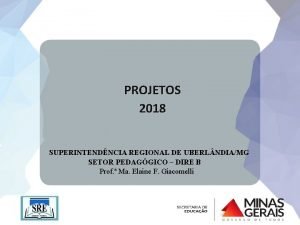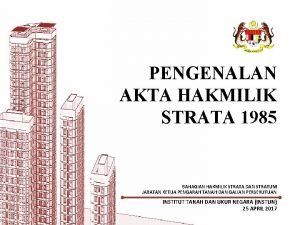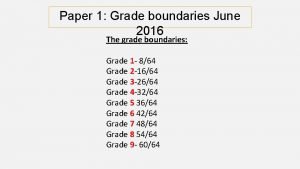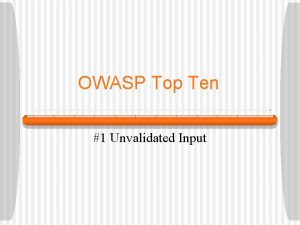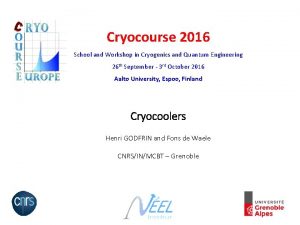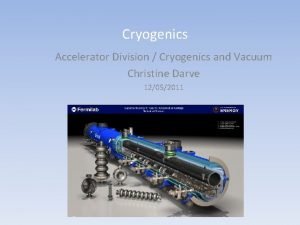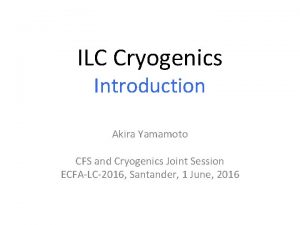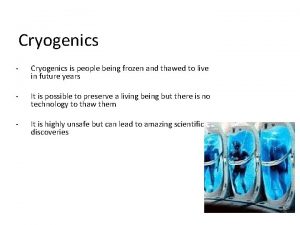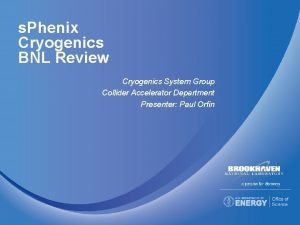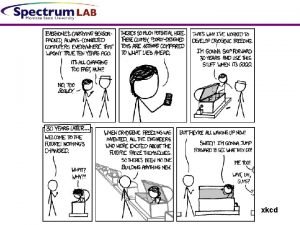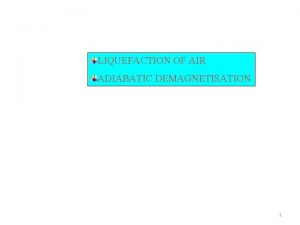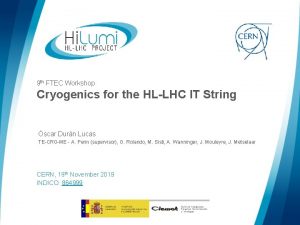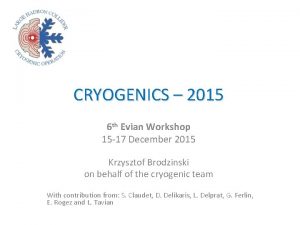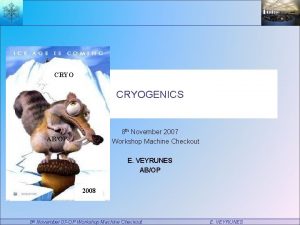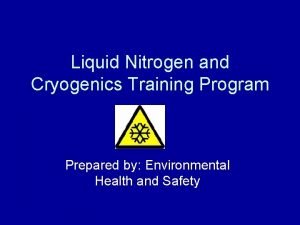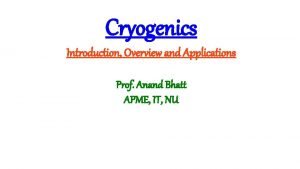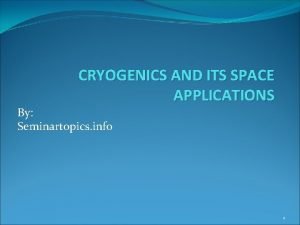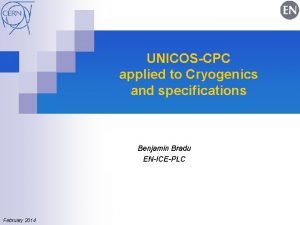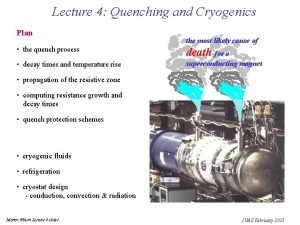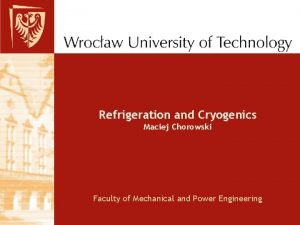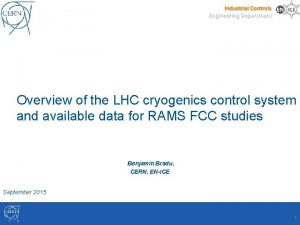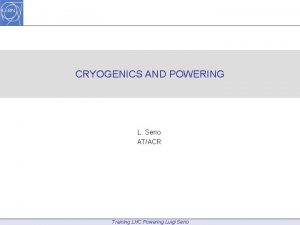Cryocourse 2016 School and Workshop in Cryogenics and









































- Slides: 41

Cryocourse 2016: School and Workshop in Cryogenics and Quantum Engineering 26 th September to 3 rd October 2016 Aalto University, Espoo, Finland Dilution refrigerators Part II: design and operation Henri GODFRIN CNRS/IN/MCBT – Grenoble

Refrigeration: Temperature range

Cooling power

General considerations Dilution Refrigerators - Minimum temperature T= 2 m. K in CONTINUOUS operation. - Cooling power = 82 dn/dt T 2, for T>3 Tmin - Sophisticated machines! Do you really want to have a DR? ? ? - Use a 3 He cryostat if you do NOT need temperatures below 0. 3 K! - Advantages of a 3 He cryostat : - Higher cooling power - Simplicity of operation - Gain in operation time - Reduced risk of failures - Troubleshooting is easier - Reduced initial and maintenance costs - Saves laboratory space

Schematic view of a DR

The mixing chamber

The 1 K pot • Thermalizing 3 He • … and other stuff!! • 4 He Flow rate • 4 He Volume stored • Filling capillaries • Cold valves • Filters • Level sensing? • Vibrations!

Condensing the 3 He Thermalizing in 4 He bath Thermalizing on 1 K pot Thermalizing on still Thermalizing in continuous exchanger

No 1 K pot? • Condensation pressure higher • Compressor needed (essentially during initial condensation) • Risk of leaks • More 3 He needed (cost!) • But it is so nice to live without the 1 K pot problems!!!

The mixing chamber • The heart of the dilution refrigerator • Large volume: • easier determination of amount of mixture • stability against pressure changes • Heat exchanger made out of sintered silver powder • Magnetic fields: plastic mixing chambers • Conical or flat plastic plugs for easy access

Heat exchangers & cold plate

Sintered silver heat exchangers

The still Large volume, large area Do not fill, only a few mm! Film burner and/or diaphragm

The complete drawing!

The real thing!

Cooling power of a DR as a function of the flow rate

Cooling power as a function of temperature (Tmin of this DR = 5 m. K)

Vibration isolation

Well, you decided to have a DR… (or you had no choice!) - There are many kinds of dilution refrigerators: - Classical, Helium (and nitrogen? ) bath: Ultralow temperatures, measurements with superconducting coils, special samples. . . ). Several manufacturers: Air Liquide, Cryoconcept, Leiden Cryogenics, Oxford Instruments, etc. - With partial cryogenic bath and shields (DRILL, Sionludi) (neutrons, X-rays, etc. . . ) “Table cryostat” Air Liquide, Oxford Instruments, … - Pulse-tube Dilution refrigerators: Air Liquide, Leiden Cryogenics, Blue. Fors Cryogenics, Oxford Instruments, Cryoconcept, Vericold, … - "top loading" : fast measurements with small samples, Oxford Instruments, … - Inserts (Neumeier, Garching), ILL - Horizontal (Niinikovskii, CERN) - 4 He circulation (de Waele, Eindhoven; Schumacher, Grenoble)

Some choices… Precooling stage: - With 1 K pot? - Joule-Thompson stage? Pumping: a rotary pump and…? - diffusion pump? - Roots? - Turbo-molecular pump? - Adsorption pump?

Design considerations Obtaining low temperatures and high cooling power (dn/dt >100 µmoles/sec): 1) optimisation by a careful calculation: - heat exchangers (sintered silver powder step exchangers). - conduction and viscous heating in the low temperature parts. - pressure drop in the pumping lines. - condensation of the mixture 2) Optimisation of the mechanical parts: - vibrations - viscous heating 3) Empirical optimisation (know-how!): - circulation of 4 He - interaction of the dilute 3 He on the excitations of 4 He 4) Optimisation of the reliability: - simple design - modularity - foresee leak testing by elements 5) Training the operators!

Where do I put my DR now…? ? ? • Check-list: • • • Space available: area, height… Door width (can the DR Dewar enter the room? ? ) Do I need to make holes in the floor or ceiling? Dewar, pumping lines… Room for the helium and nitrogen storage dewars? Room for the pumps? Electrical power? Water? Compressed air? Helium recovery lines? Anti-vibration system? Shielded room? • Adapt the design to the needs. • Adapt the design to the constraints



Table-top Dilution Refrigerator 50 m. K CNRS – Air Liquide A. Benoit STM, AFM, optical access…

Base temperature < 30 m. K Stability @ 30 m. K 0, 1 m. K 250µw @ 100 m. K Less than 16 hours for 300 K-30 m. K Liquid helium hold time 48 hours (up to 10 days with automatic refill)

DRILL – 5 m. K DR for neutron scattering

DN 1: Dilution refrigerator for ultra-low temperatures

PT-DR 1 (1999) and PT-DR 2 (Commercial unit delivered 2003) H. Godfrin, S. Triqueneaux (CNRS & Air Liquide) Th. Prouvé, S. Triqueneaux, H. Godfrin

Pulse-Tube dilution refrigerator PT-DR 2 (industrial collaboration with l’Air Liquide)

Commercial unit PT-DR 3 CNRS - Air Liquide

Base temperature < 10 m. K 400µw @ 100 m. K Stability @ 20 m. K 0, 1 m. K 10 µw @ 20 m. K High temperature 30 K

Base T: At 100 m. K: At 20 m. K: 3 He requirement: With DU 7 -500 dilution unit 8 m. K typical, < 10 m. K guaranteed 500 μW typical, 450 μW guaranteed 15 μW typical, 12 μW guaranteed With DU 7 -300 dilution unit 8 m. K typical, < 10 m. K guaranteed 300 μW typical, 250 μW guaranteed 10 μW typical, 8 μW guaranteed 18 litres STP 11 litres STP


Playing with the mixture… • Calculate all the volumes of all circuits inside the RD, and also in pumps, traps, lines, etc… • Calculate the amount of 3 He and 4 He gas needed • Remember that the still has less than 1% concentration of 3 He… • Mixing Chamber should be large for stability… • Start with minimum amount of mixture! • Best operation with small amount of mixture in the still, and small amount of concentrated phase in mixing chamber

Condensation of the mixture • Pre-cooling of cryostat at 4 K • Pump the exchange gas (pump or adsorption) • Check tanks pressure • Check LN 2 (eventually LHe) traps • Circulate mixture through the traps. • Long condensation process (hours) • Condensation temperature must be low to avoid additional delays. • Start circulation. With tricky cryostats, start with high flow rates (4 He low points)

Operating the RD… • Flow rate is determined by the still power, not by the pumps! • This is NOT true for PT-DRs (no 1 K pot, large heat of condensation) • Choose adequate flow rate (high power, or Tmin ? • With high circulation rates, 4 He poisoning of the RD. • High temperature ( T> 1 K) operation: remove mixture, use only the mixture of the pump.

Warm-up • Removing the mixture takes a long time • Heating the MC and Still: not very efficient! • Exchange gas? Caution! Unstable, keep P < 10 -4 m. Bar • Close tanks, put rest of the mixture in the pump, close the pump. • Traps: throw away (pumping) what was not pumped when the nitrogen trap was cold. • Do not allow water condensation on RD…

Troubleshooting • 1 K pot hot, pressure is low. Filling capillary blocked. Remove LHe so that the bath level is below the intake, keep 4 He pressure in Pot above bath pressure. Heater on capillary… • High inlet pressure. Air? Hydrogen? Water? • Low still pressure. Still empty? Check T vs. P! • No cooling power. Interface level in MC? Heat leak to MC? Apply heat and check cooling power at higher temperatures. 3 He/4 He ratio OK? • Heating spikes, oscillations. Superfluid leak to Vacuum can?

Good luck! • Building a dilution refrigerator is NOT easy • Repairing a dilution refrigerator is even worse. We told you…. !

Pulse-tube 3 He/4 He Dilution refrigerators
 Cryogenics palm harbor
Cryogenics palm harbor Kirk welding supply
Kirk welding supply What is the difference between 29 028 and 1 312
What is the difference between 29 028 and 1 312 Practical cryogenics
Practical cryogenics Gde
Gde Sps cryogenics
Sps cryogenics Looking at our school 2016
Looking at our school 2016 Looking at our school 2016
Looking at our school 2016 Astro quiz 2019 round 2 answers
Astro quiz 2019 round 2 answers Astro quiz 2016 questions and answers
Astro quiz 2016 questions and answers Widows and orphans word 2016
Widows and orphans word 2016 Unit 6 level b synonyms
Unit 6 level b synonyms Vocabulary workshop level e unit 13
Vocabulary workshop level e unit 13 A factual description
A factual description Vocabulary workshop level g unit 12 answers
Vocabulary workshop level g unit 12 answers Vocabulary workshop level d unit 5 synonyms
Vocabulary workshop level d unit 5 synonyms Level f unit 8 synonyms
Level f unit 8 synonyms Hair and body workshop montmorency
Hair and body workshop montmorency Pros and cons of reading workshop
Pros and cons of reading workshop Workshop health and safety poster
Workshop health and safety poster Vocabulary workshop level g unit 15 completing the sentence
Vocabulary workshop level g unit 15 completing the sentence Vocabulary workshop level d unit 13 antonyms
Vocabulary workshop level d unit 13 antonyms Calendar xx
Calendar xx Zpg biologie 2018 lösungen
Zpg biologie 2018 lösungen Accuwage 2016
Accuwage 2016 Vaap curriculum framework
Vaap curriculum framework Who anc model
Who anc model Movie maker 2016
Movie maker 2016 Tni standards
Tni standards Grant showplan
Grant showplan Skype statut absent automatique
Skype statut absent automatique Informe técnico 1228-2017-servir-gpgsc
Informe técnico 1228-2017-servir-gpgsc Kugabana umutungo
Kugabana umutungo Continuing professional development act
Continuing professional development act Resolução da see/mg no 2957 de 20 de abril de 2016
Resolução da see/mg no 2957 de 20 de abril de 2016 Erin kathryn
Erin kathryn Portaria interministerial no 424 de 30 de dezembro de 2016
Portaria interministerial no 424 de 30 de dezembro de 2016 Deped order no. 36 s. 2016
Deped order no. 36 s. 2016 Hak milik strata
Hak milik strata The skin cracks like a pod
The skin cracks like a pod Owasp top ten 2016
Owasp top ten 2016 System center operations manager 2016
System center operations manager 2016
